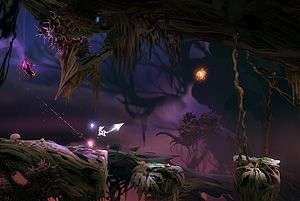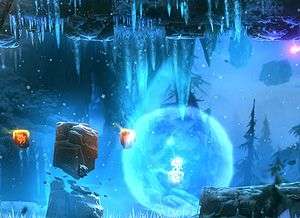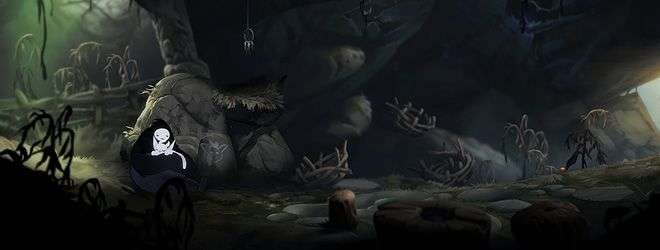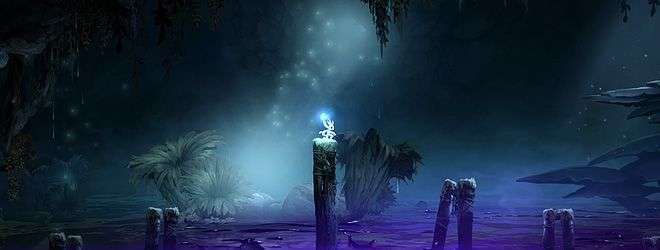Ori and the Blind Forest – Review
by Neil
|
 The first thing you’ll probably notice when playing Ori and the Blind Forest is how absolutely beautiful it is. It has the most well-realised art direction of any game that I have seen in quite some time. Every aspect of its design, from the animation to the music and narration, all come together perfectly and the result is a game that will occasionally make you coo with appreciation. In a lot of ways this game reminds me of a Studio Ghibli film, like Spirited Away or Princess Mononoke, it just oozes enchantment and otherworldliness from every pore – believe me, this is not as twee as it sounds. All of this can be seen in both the game’s trailer and the opening ten minutes or so, which plays out more as a vaguely interactive animation than a conventional game.
The first thing you’ll probably notice when playing Ori and the Blind Forest is how absolutely beautiful it is. It has the most well-realised art direction of any game that I have seen in quite some time. Every aspect of its design, from the animation to the music and narration, all come together perfectly and the result is a game that will occasionally make you coo with appreciation. In a lot of ways this game reminds me of a Studio Ghibli film, like Spirited Away or Princess Mononoke, it just oozes enchantment and otherworldliness from every pore – believe me, this is not as twee as it sounds. All of this can be seen in both the game’s trailer and the opening ten minutes or so, which plays out more as a vaguely interactive animation than a conventional game.
The opening of the game details the origins of Ori, a white fox-like forest spirit and the main protagonist of the game. We are also introduced to the antagonist, a huge shadowy owl that has stolen the light essence from the magical forest of the game’s setting. The plot kicks off with Ori, joined by a glowing spirit named Sein (who is very reminiscent of Navi from Ocarina of Time), travelling to recover three elements to save the dying forest. So that’s the basic gist of it, there are the usual high points and low points, and twists and turns, but the core of the plot is refreshingly simple. Despite this simplicity, the delivery of the plot through short narrated cut-scenes allows the game to maintain a sense of charm throughout without being overly intrusive and, at points, it can even be quite moving.
After the initial semi-interactive opening, the game settles nicely into a familiar Metroidvania style. The player moves through the forest gaining abilities as they progress, allowing them to access new areas that had previously been closed off to them. An experience-based levelling system and skill tree are also present, and these allow room to develop the many skills in any order you see fit. Although the skill tree will provide you with advantages such as increased damage and double/triple jumps, the main skills that open the game up are unlocked at set places and points in the story. This keeps the pace of the game flowing nicely; even though I put a lot of effort into levelling up by gathering the various collectables throughout the game, I never felt particularly overpowered although many of these skills definitely helped to cushion some of the challenge.
 Combat is fairly simple throughout; enemies are fought by blasting them with balls of energy from Ori’s companion, Sein. The addition of an explosive AoE attack, a downward dash, and the ability to redirect enemy projectiles also helps to offer some alternative approaches to combat. There are a number of different enemy types that seem to have been included with the intention of encouraging you to mix up your play style, however most enemies can be defeated by simply spamming the basic attack. The simplicity of the combat is mostly acceptable since it never really feels like the main risk of the game; most of my deaths instead came from environmental dangers.
Combat is fairly simple throughout; enemies are fought by blasting them with balls of energy from Ori’s companion, Sein. The addition of an explosive AoE attack, a downward dash, and the ability to redirect enemy projectiles also helps to offer some alternative approaches to combat. There are a number of different enemy types that seem to have been included with the intention of encouraging you to mix up your play style, however most enemies can be defeated by simply spamming the basic attack. The simplicity of the combat is mostly acceptable since it never really feels like the main risk of the game; most of my deaths instead came from environmental dangers.
Ori and the Blind Forest lured me in with its presentation; it appeared to be a game focused primarily on its aesthetics and charming story, but secretly it has teeth. Big, nasty, sharp teeth. If you’re anything like me, you will die a lot. I died so frequently that at points it felt as if I were playing Super Meat Boy and struggling through its insanely challenging platforming. Much like in Super Meat Boy, respawning in Ori and the Blind Forest is almost instantaneous. These fast respawns, combined with the ability to place your own respawn point in any safe area, thankfully stops the constant death from becoming annoying and instead turns the challenge into an extremely rewarding experience.
Although difficult, Ori and the Blind Forest is very rarely frustrating. The level design is of extremely high quality and failure almost always feels like it is due to player incompetence rather than any unfair odds within the game itself. Unfortunately, when Ori and the Blind Forest is frustrating, it is to the extreme, almost to the point where pulling out your own hair can seem like a preferable alternative to playing any longer. These frustrating segments are thankfully limited to short escape sequences sparsely dotted throughout the game. In these sections you must move quickly to avoid an oncoming threat, like water or lava, and dodge various environmental dangers along the way. These sections are particularly frustrating because a death will place you right back to the beginning of the sequence. Often, these deaths seem entirely unavoidable and the only real way to advance is to die over and over again until you eventually learn the layout of the area.
 At times I found myself dying repeatedly in the same two seconds of gameplay before finally advancing. These sequences feel entirely out of place and offer little to the experience beyond a unique opportunity to repeatedly and vigorously test the tensile strength of your controller. When you do finally complete one of these sequences there is no real sense of achievement, only a feeling of relief that it’s finally done with. Unfortunately, this pulls some of the joy from the game alongside interrupting its flow. Sadly, this is most noticeable at the game’s conclusion, which involves possibly the most irritating segment of gameplay I’ve ever experienced, and dampens what should be a compelling and satisfying ending to an excellent game.
At times I found myself dying repeatedly in the same two seconds of gameplay before finally advancing. These sequences feel entirely out of place and offer little to the experience beyond a unique opportunity to repeatedly and vigorously test the tensile strength of your controller. When you do finally complete one of these sequences there is no real sense of achievement, only a feeling of relief that it’s finally done with. Unfortunately, this pulls some of the joy from the game alongside interrupting its flow. Sadly, this is most noticeable at the game’s conclusion, which involves possibly the most irritating segment of gameplay I’ve ever experienced, and dampens what should be a compelling and satisfying ending to an excellent game.
Overall, Ori and the Blind Forest is around seven hours long if you don’t rush and take the time to collect all the various orbs and other collectables scattered throughout. The length of the game will almost certainly be related to your own skill and ability, so if you’re particularly useless you may find it lasting significantly longer. Despite the occasional frustrating sequence, Ori and the Blind Forest is a delight to play; alongside its stunning aesthetics it also has some truly challenging and rewarding gameplay, and a charming story that will keep you hooked throughout. An enhanced edition is due for release some point in spring which will add some additional abilities and areas to explore, so if you’re interested it may well be worth waiting until then to pick this game up.
Pros- Gorgeous art direction
- Like playing a Studio Ghibli Film
- Challenging but rewarding gameplay
- Occasionally incredibly frustrating
Ori and the Blind Forest is a great all-round experience. It is beautiful, but also challenging, and very rewarding to play. If you can stomach the occasional frustrating sequence then this really is an outstanding game and well worth your time.
Last five articles by Neil
- Stellaris Diary Part 4: Falling to the Fallen
- Stellaris Diary Part 3: Attack on the Empire
- Stellaris Diary Part 2: An End to Slavery
- Stellaris Diary Part 1: Penguins and Arses
- Firewatch - Review























Great read, I’ve seen Ori kicking around on steam, not my bag but it is beautiful.
Welcome to the site mate.